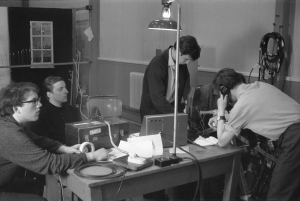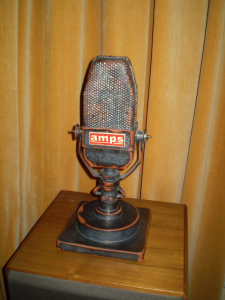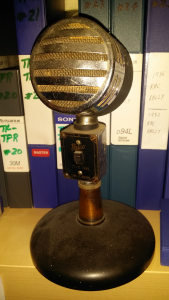Geoff Fletcher
An AXBT in use in our remote source studio in the wooden huts at Wood Norton. Barry Chatfield was the presenter for our programme exercise which we entitled "Today". I believe Barry became a TM in Birmingham eventually.
(Click on the picture below to see larger version:
use your Browser’s BACK button to return to this page)
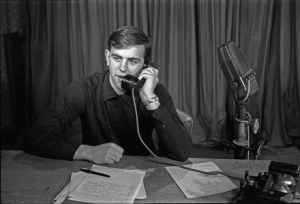 |
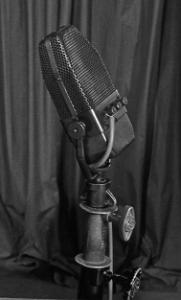 |
Dave Buckley, Geoff Fletcher
The ‘diamond shaped mic’ was probably an AXBT (or possibly the earlier AXB) which was actually a ribbon mic.
(Click on the pictures below to see s larger version:
use your Browser’s BACK button to return to this page)
There was someone at TVC – I think her name was Sonia – who had an archive of such mics in a cupboard. I know she was itching to get her hands on one of the AKG C24 mics TV Training had!
Patrick Heigham
In my film industry career after TVC, I joined and subsequently became Membership Secretary of AMPS (Association of Motion Picture Sound). On retiring from said office, I was presented with a beautiful ceramic casting of an AXBT – highly detailed even to the screw cable connectors at the back. I don’t know where the sculptor obtained one, but I wished mine was real!
John Howell
It was indeed Sonia, but what happened to the microphones? I haven’t seen any in the TVC equipment auctions, there was an AXBT among them. I used it as a vocal mic on the Bob Kerr Whoopee Band. (the Director complained that it was so big he couldn’t see the artist).
There was also an Electrovoice 643 rifle mic which was seven feet long, where did they all go?
John Nottage
We used the 7 ft rifle mic at Ascot when I first worked there. It was rigged up on the roof. It came in 2 pieces you had to join together and it had an 8inch(?) diameter foam windshield around it.
Dave Buckley
I remember the 7 ft rifle mic!
TV Training borrowed a few times to show to overseas training courses. It caused quite a stir! We would point it out of the one of the windows in the studio and see what could be picked up.
The problem was getting Sonia to let us have the mic as they were all practically under voice lock!
Richard Greene
Sonia Harrison used to work for Tech Stores. She and the Sound Organisers built a ‘museum’ of as many of the vintage mics as they could lay their hands on. Sonia was very good at this as, through her contacts at Avenue House, she was able to glean examples from the Regions and OBs too.
In 1986, when I became Sound Organiser, there were two AXBTs, both re-boxed in Custom flight cases, however that number went to three on the retirement of Adrian Stocks. When The Bear returned his cans and Safety Regs he handed me a carrier bag containing an AXBT and the remains of its box. The story was that many years before he and Potts had been clearing ‘redundant’ equipment from Stores and rather than junk everything he had asked if he could look after an AXBT for ‘old times sake’. He was given permission, provided it was returned on his retirement. How about that for honesty! The mic went to Avenue House and was restored and the ribbon retuned. The quality was stunning!
When I finally left in 2009 the museum was handed back to the Sound Department. Graham Heath appeared to be looking after it, and there still was an Electrovoice rifle!
Regrettably I have seen a number of those mics (not the AXBTs!) in the recent sales, but I know that at least one, a 4033, is in safe hands.
Tony Crake, John Howell
There was another long rifle mic, the Labor MD82. They had one at Wood Norton, John Howell was not popular when he suggested it was better ‘without the long tube thingy screwed to the front’. It was a stores item in TVC.
Jeff Baker
The two rifle mics that the BBC bought before the Sennheiser was available were the Labor, which was probably 36 inches long, and the Electro-voice which was considerably longer, maybe about 5 feet. The Labor could mount on the large cameras of the day but neither could match the Sennheiser for quality.
Chris Woolf
The Labor was a Sennheiser – it was produced by the Sennheiser Labor W(ennebostel) factory. I think there was a version before the MD82 – the first ever interference tube mic – before the more polished MD82, c1956.
John Nottage
When I joined OBs in ’69, the only gun mics were the Labor and the Electrovoice. The Labor was a long grey tube with a bulge at the back for the works. There was no windshield. They were the standard mic to fit on cameras for sports fx. There was some odd plug at the back which was later modified to XLR. I’ve no idea how they sounded: I was just a lowly oik and not allowed in the scanner during shows! The Sennheisers didn’t arrive for some time – the battery powered 815 first. It was even longer before the phantom powered 816 arrived. Eventually the 416 came along too, but until then, we did all our drama on the C451 with the CK9(?) capsule which was very delicate. I lost count of the number that broke when the fishing rod fell over. I don’t know if SS VG kept using them after the 416 arrived, but I thought that most switched as soon as they could.
Pat Heigham
When I shifted from Feature films to (very interesting) doco work, the standard workhorse mic in all the provided sound kits from facilities companies was the 416. I hated it, since the frequency response changed as one came off axis. I liked to balance uneven voices on a two hander I/V by dextrous favouring, thus keeping the b/g exterior atmos at the same level rather than riding the pot. Couldn’t do that with a 416. Building my own kit I much preferred the MKH60, a bit longer and fatter, but very smooth off-axis, no change in freq. quality, just a drop in level, which was what I needed.
Tony Crake
A gun mic story:
Penny Kift and I were doing some inserts for some highly forgettable drama, the SS of the day going by the initials VG ordered us to rig CK9s in the rods.
We looked somewhat puzzled (“nobody uses those,” we thought). However we did as he asked.
"Have you got those Pair 1 and Pair 2? "
"Pair 1 is OK … Pair 2 is buzzing"
At this point Penny somehow trod on the cable to Rod 2, which forcibly ejected the CK9 from its mounting, smashing it flat onto a solid tiled floor. The mike disintegrated. There were all sorts of ‘sprockets, springs and screws’ rolling across the floor.
"That’s fine now," said VG. "The buzzing stopped now… sounds quite good!"
We fell about! Needless to say we put the CK9s back in the box (+ red label) and started off the following day with 416s without actually telling VG… Lovely mics those 416s!
And back to mics:
Gary Critcher
I bought this in an auction fair in Chelsea Town Hall about 1995:
(Click on the picture below to see larger version:
use your Browser’s BACK button to return to this page)
John Howell
It looks more like a Public Address mic from the 1930s. Trix did one similar, as did Grampian in 1939. Just a moving coil mic with a switch.
Chris Woolf
Looks like a Reslosound VMC – might be a VMC2 but the grilles vary a bit, as do the way they are mounted on stems with and without switch bodies, so it is hard to be sure.
VMC was "Velocity Moving Coil" which tells you what you need to know – it is not the ribbon version usually associated with Reslo. The grille arrangement and name suggests that it was a two-port device with some directionality, though how good that was I’ve no idea.



